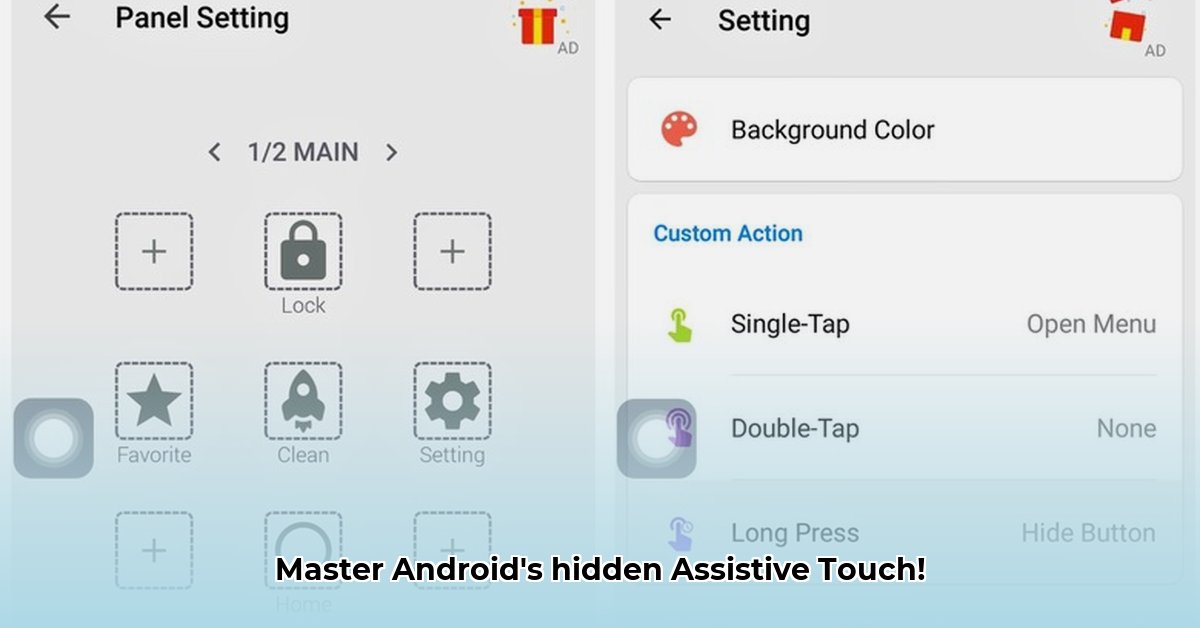
Assistive Touch Android: Your Personalized Phone Helper
Using your Android phone shouldn't be a struggle. AssistiveTouch simplifies phone interaction, making it more accessible and intuitive. This guide covers everything from setup to advanced customization, empowering you to use your phone more efficiently regardless of your abilities. Whether you face mobility challenges, visual impairments, or simply seek a faster workflow, this guide will help maximize your AssistiveTouch experience.
What is Assistive Touch Android?
AssistiveTouch is a personalized control center, a floating panel providing easy access to essential phone functions. Instead of straining to reach screen elements, you tap this readily available panel. This is especially beneficial for individuals with limited mobility or dexterity. It's like having a dedicated on-screen assistant.
Consider scenarios where reaching the top of a large phone is difficult. With AssistiveTouch, you position a screenshot button within easy reach. The level of customization is remarkable; you define the buttons, their placement, size, and even transparency. It adapts to your needs.
This isn't just for those with disabilities; anyone seeking faster, simplified phone use will benefit. Constantly switching apps or adjusting volume? AssistiveTouch buttons can streamline these actions. It's also invaluable for large-screen phones, enabling easier one-handed operation.
Setting Up Your Assistive Touch Helper
Setup is typically straightforward, though steps might vary slightly based on your phone's brand and Android version. Generally, follow these steps:
- Access Phone Settings: Usually represented by a gear-shaped icon.
- Navigate to "Accessibility": Find the menu containing settings for enhancing phone usability. The exact name might vary slightly (e.g., "Accessibility features," "Special access").
- Activate "Assistive Touch": Locate and activate this feature.
- Personalize the Panel: This is where you define the buttons, their arrangement, size, color, and transparency. Some phones offer extensive customization, while others provide a more basic setup.
Many users appreciate this extensive customization. You tailor the look and feel to your exact preferences. Third-party apps sometimes provide additional functions or aesthetic changes.
Personalizing Your Assistive Touch Experience
The beauty of AssistiveTouch lies in its adaptability. Once activated, thoroughly explore the customization options.
Here are some common functions:
| Function | Description |
|---|---|
| Home | Returns to your home screen. |
| Back | Navigates to the previous screen or page. |
| Recent Apps | Displays recently used applications. |
| Volume Control | Quickly adjusts your device's volume. |
| Screenshot | Captures a screenshot of your current screen. |
| Notification | Opens your notification shade. |
| Custom Actions | Allows you to assign your own actions. |
Analyze your phone usage patterns. What actions are most frequent? Place these on your AssistiveTouch panel for instant access. Experiment – you might uncover new workflow efficiencies.
The Advantages and Drawbacks of Assistive Touch
Like any tool, AssistiveTouch has pros and cons:
Pros:
- Enhanced Accessibility: Easier phone use for individuals with mobility limitations.
- One-Handed Operation: Facilitates one-handed use of larger phones.
- High Customization: Tailored to individual needs and preferences.
- Ergonomic Benefits: Reduces hand and wrist strain.
Cons:
- Screen Space: The on-screen panel occupies a small portion of your screen.
- Potential for Distraction: The floating buttons might be visually distracting for some users.
- Feature Variation: Functionality and customization options vary across devices and Android versions.
Ultimately, AssistiveTouch's suitability depends on individual needs. For many, the benefits far outweigh the drawbacks.
Conclusion and Future Outlook
AssistiveTouch significantly improves Android usability. By personalizing this tool, you unlock a more accessible and enjoyable mobile experience. Ongoing advancements in assistive technology promise even more sophisticated versions. Stay informed about updates and new features. Experiment to optimize your settings for the best possible user experience. Your ideal, customized phone setup is within reach.
Improving Assistive Touch App Usability for Motor-Impaired Users
Millions rely on mobile assistive technologies. While helpful, AssistiveTouch presents usability challenges for motor-impaired users. Improvements focus on enhanced customization, larger interaction targets, and alternative input methods. Developers and users can collaborate to improve accessibility. Future technological advancements promise more intuitive and personalized options.
Optimizing AssistiveTouch Through Customization
Personalization is key. Android's AssistiveTouch offers extensive customization:
- Adjust Button Size and Transparency: Larger buttons are easier to target. Adjust transparency for better visibility.
- Reposition the Floating Menu: Move the panel to accommodate your hand position and reach.
- Customize Actions: Assign frequently used functions (Back, Home, Recent Apps) to the main menu.
- Explore Single-Handed Mode: Optimize for one-handed operation if needed.
Advanced Customization Techniques
Beyond basic settings:
- Utilize Third-Party Apps: Explore apps offering larger activation areas, custom gestures, or haptic feedback.
- Integrate Voice Control: Combine AssistiveTouch with voice commands for hands-free control.
- Explore Alternative Input: Experiment with switch controls or head tracking.
Collaborative App Development for Accessibility
App developers play a crucial role:
- Larger Touch Targets: Ensure interactive elements are large enough for easy activation.
- Clear Visual Cues: Use prominent visual feedback for actions.
- Predictable UI: Maintain consistent and intuitive user interface layouts.
- Simplify Gestures: Minimize complex interactions.
Here's a breakdown of specific improvements:
| Feature | Improvement Strategy | Example |
|---|---|---|
| Button Size | Increase size significantly | Double or triple the default size |
| Menu Organization | Prioritize frequently used actions | Place Back and Home buttons prominently |
| Haptic Feedback | Implement distinct, noticeable haptic feedback | Strong, clear vibrations |
| Gesture Simplification | Favor single taps over complex gestures | Use single taps where possible |
The Future of AssistiveTouch
Future innovations promise significant improvements:
- AI Integration: AI predicting user needs and proactively suggesting actions.
- Advanced Predictive Text: AI-powered text prediction to enhance typing efficiency.
- Biometric Controls: Eye-tracking or other biometric interaction methods.
These advancements empower individuals with diverse needs to fully engage with the digital world. Improving AssistiveTouch requires a collaborative effort from developers, users, and researchers.
⭐⭐⭐⭐☆ (4.8)
Download via Link 1
Download via Link 2
Last updated: Sunday, May 04, 2025